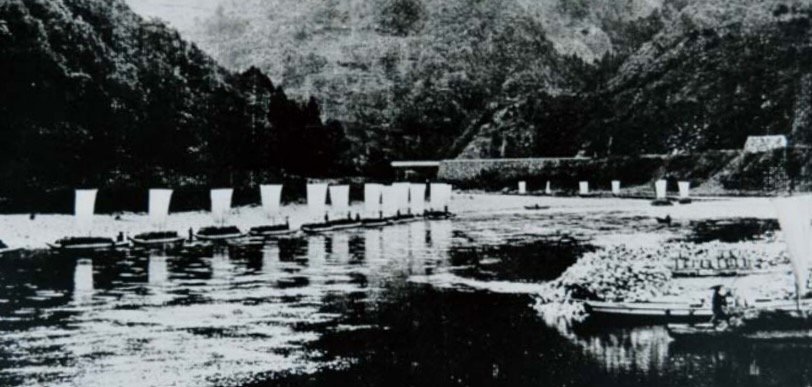Kumagawa Kudari River boats
-
In 2019 I was approached by the owner of the Kumagawa Kudari, a downriver tour boat company located in Hitoyoshi, Kumamoto on the Kumagawa River. He had recently purchased the company and wanted to renew his fleet of six thirty-six foot wooden boats. His last boatbuilder was 83 years old and unable to take on the project, so he proposed that I come to Hitoyoshi and build two new boats, returning in a few years to build two more, until he had a new fleet.
COVID hit in early 2020 and Japan shut down to outside visitors. Then in the summer of 2020 the Kumagawa saw some of its worst flooding in history. The company’s shoreside buildings were destroyed and all six boats were damaged beyond repair. The owner then asked me to plan on building six new boats at a different venue. In 2007 I had built a new tour boat for Ritsurin Koen, a Japanese garden in Takamatsu. Then I worked for a company called Yuuwamokusou, located just east of the city. I approached them to be my partner in the river boat project, and they agreed. It would take another two years to secure a building site, materials, and a visa for me and my assistants, but I built the six boats over three sessions between October of 2022 and December of 2023.
-
The Kumagawa Kudari has been taking tourists down the Kumagawa River since the early 1900s. The boats have remained largely unchanged throughout its history. The river is a fast-running, white water stream and the skill of the boatmen (to date all have been men) is paramount. In fact for many years all the boatmen traditionally came from one small neighborhood in Hiteyoshi.
One unusual feature is the bow oarsman, who mans an oar projecting ahead of the boat as it rushes downstream. Their job is to turn the bow quickly to navigate sharp bends in the river. The position is extremely precarious and it takes three years to master.
-
Another interesting feature of these boats, as well as many other types I have seen on rivers in Kyushu, is a hollow in the bottom planking. The elderly boatman who advised us as we measured a surviving boat in 2022 said this hollow was absolutely necessary, as it trapped air and gave the boat speed. This makes sense as this would reduce the wetted surface of the hull and reduce friction.
My assistants and I built the six new boats working in a rented shop in Sanuki City, Kagawa, nine hours away by truck from Hitoyoshi. We used a western system of temporary molds but otherwise the construction was all traditional. The bottoms of the boats were fiberglassed to protect from abrasion of the rocky river bottom.
You can see a series of videos shot during the project by clicking the YouTube icon at the bottom of this page. You can read my article in Mortise & Tenon magazine about the project here.
One of a fleet of six downriver tour boats my assistants and I built for the Kumagawa Kudari in Kumamoto, Japan.

Justin Morande walking past the backbone assembly with the first two planks laid out to bend and clamp in place for fastening.

The third, fourth, and fifth boats of the six we built, in various stages of construction.

The boats have three beams for framing. Others seen here are temporary to hold the hull's shape during construction.

Rowan Shaw-Jones planing the plank ends smooth flush to the stem.

A completed boat. Simple side benches for the passengers and floorboards complete these boats.

We used molds, a western technique, mainly because we couldn't prop planks in place on a hard, concrete floor.

Two garboard planks assembled and laying out their shape with our full-size pattern.

The fifth boat finished and the final boat started. We had to build an overhead beam structure so we could bend the bottom with a hollow in the middle, something traditionally found in these boats.

Our 93-year old neighbor joined us for a simple Shinto ceremony at the completion of the final boat.

Our first boat after delivery to the Kumagawa Kudari in Hitoyoshi, Kumamoto. The bottom is fiberglassed to the chines. Photo courtesy the Kumagawa Kudari.

The crew at the bow literally rows the boat through tight turns. It is a highly skilled and dangerous position. Photo courtesy the Kumagawa Kudari.

Photo of the company's boats in the 1960s, when the fleet numbered about fifty. Now they six boats. Photo courtesy the Kumagawa Kudari.

Note the shoe box aft. The calm looking woman is a tour guide, accustomed to the wild ride. Photo courtesy the Kumagawa Kudari.

Historically similar boats were used to take cargo downriver and could return upstream with prevailing winds. Photo courtesy the Kumagawa Kudari.

A tour in the 1920s. Note the thin splashboards mounted on the rail. Photo courtesy the Kumagawa Kudari.

The position at the bow is considered the most highly-skilled job. Traditionally this position was hereditary. Photo courtesy the Kumagawa Kudari.

Two tour boats pass the Hitoyoshi Castle ruins. Photo courtesy the Kumagawa Kudari.
